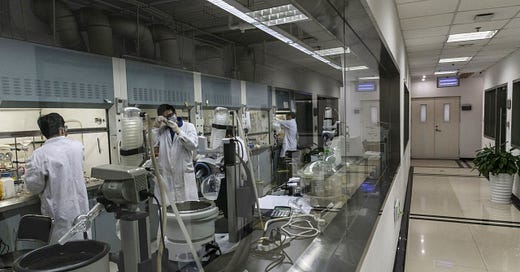Another year, another wave of reports of dangerous “Chinese Imports” flooding our borders. The usual culprits? Unmarked barrels offloaded at dark in Long Beach, filled with suspicious white powders. Shady chemical precursors synthesized in dimly lit industrial parks outside Wenzhou, packed into shipping containers to be cut and sold in the streets of New Jersey and Bakersfield.
For all of that noise however, no one seems to care about the other Chinese drugs slipping through the ones that don’t come in plastic baggies, but in sterile vials, syringes, and pharmaceutical refrigerators. Not just generic unlicensed copies, but genuine innovation. More effective, more affordable, and inconveniently, more innovative than some of the things coming out of the American system.
Follow the Leader
Like her sister industries in Machine Learning, Computer Hardware, EV’s and Green Energy. China’s biopharmaceutical sector has employed a “fast follower” strategy to expedite development and reduce costs. The best example of this that the majority of readers would be familiar with is the drama between ChatGPT and DeepSeek, with its free model being on par with ChatGPT’s 20$ a month subscription
It is largely the narrative that we see where Chinese firms copy, improve upon or make cheaper, and then put it out to market to outcompete the original American product. Even within this space, a majority of the Chinese pharmaceutical industry still is based on drugs innovated in the U.S. This allows Chinese firms to spend less on the initial stages of R&D before putting something to market without having to start from complete scratch. This was the case up until recently.
The important thing to note for these private firms are how they are funded, public hospitals and clinics funded by the government made up 63.5% of all pharmaceuticals sold, with private clinics and insurance taking up only 9.6% with the remainder being OTC drugs sold in pharmacies.
The Keytruda Phenomenon
In the landscape of oncology, few drugs have made as profound an impact as Merk’s Keytruda. Approved by the FDA in 2014, Keytruda marked a significant advancement in cancer immunotherapy by targeting the PD-1 pathway, allowing the immune system to combat tumor cells more efficiently compared to similar drugs within its class.
The new drug became a phenomenon. By 2024, Keytruda had not only Merk’s top product, but the best-selling drug worldwide. Generating an eye-watering $29.5 billion dollars in revenue. According to proponents of the single-payer health system, this is the key reason why the U.S. is at the apex of innovation within the biotech space, and the loss of profits would be detrimental to the U.S. pharmaceutical industry. It is the cost that we all must pay to be able to stay on the bleeding edge of healthcare.
“People were aware that the biotech industry was growing very fast in China, but very few saw it as a real threat to the top US innovators”
However, this narrative faces challenges in light of recent developments. An experimental drug, ivonescimab, developed by the Chinese biotech company Akeso, has demonstrated superior efficacy compared to Keytruda in treating non-small cell lung cancer (NSCLC). In a late-stage clinical trial conducted in China, ivonescimab reduced the risk of disease progression or death by 49% compared to Keytruda, with patients experiencing a median progression-free survival of 11.1 months versus 5.8 months for those treated with Keytruda.
Compared to the generic copy-drugs of the past, ivonscimab is relatively novel, targeting the VEGF protein as well as PD-1 to halt malignant tumor growth. This proves that significant technological innovation can be done without putting senior-citizens and low-income families into mountains of debt.
Can the Public Sector Step in?
Evidence suggests that a well-structured single-payer system can maintain, or even enhance, the nation's innovative edge by reallocating resources and fostering efficient collaboration between public funding and our existing private sector.
Yes, it is undeniable that R&D requires intensive investment to bear fruit, however the government already does this, spending almost 806 billion dollars on all R&D development in 2024. China’s budget for R&D caps out at 667 billion dollars, making it a larger ratio compared to its GDP.
I’m also not advocating for the total state-control of all hospitals; robust private insurance and health systems exist and flourish within an environment with a public-health sector that still provide sizable profits for shareholders and their respective firms. This capital extracted from the most vulnerable of our society should instead be rerouted towards the public sector and then towards R&D to minimize negative externalities.
What else is left to do?
No, banning or limiting the license of lifesaving drugs that Chinese firms produce due to their origin is not a valid or sane economic strategy.
AstraZeneca would become the next General Motors, held on life support by a Chicken Tax. There is still a large global market for these drugs and the ding of sales that these firms will pale in comparison to the collaborative innovation lost as well as the possible retaliatory policy from Bejing that would actually cripple the U.S biotechnology industry.
Such reforms should focus on streamlining the patent system to prevent the formation of "patent thickets," which can stifle innovation by creating barriers to entry for new firms. By simplifying the patent application and approval processes, reducing unnecessary bureaucratic hurdles, and ensuring that patents are granted for truly novel and non-obvious inventions, the U.S. can encourage a more dynamic and competitive marketplace to truly encourage innovation.







This is a great article!